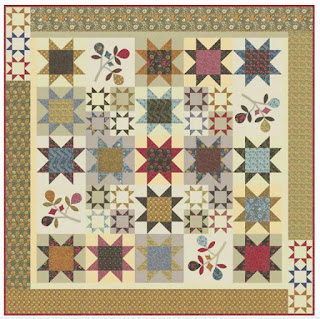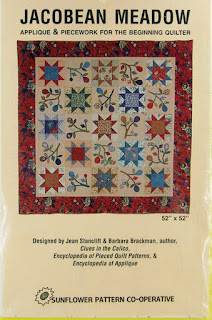Morris Hexathon 8: Greenwood by Bettina Havig
Greenwood is a single diamond shape: 12 of them.
Greenwood by Ilyse Moore
Greenwood by Becky Brown
Becky fussy-cut a tulip shape from the Compton print in Morris Earthly Paradise to give the curved look here. There are no curved seams this week.
Compton by John Henry Dearle
The diamond
A Victorian tile floor at St. Albans
The block set with red triangles about 1900
I named this basic block Greenwood for a mythical place, a symbol of the English
forest. Greenwood refers to the Anglo-Saxon culture before the invasion of the Norman French in 1066. The image is in classic British literature from Robin Hood to Shakespeare---half of a dichotomy:
- Forest and city
- Anglo-Saxon and Norman
- Ancient and Modern
- Freedom and Authority
William Morris spent his childhood near the Epping Forest, a landscape
that seduced him with a "ferocious enchantment". That two-sided view of the world shaped Morris's life and work.
The pattern is BlockBase #239, and variations have different numbers
as there are so many ways of looking at the 12 diamonds.

From the Tennessee project; photo from the Quilt Index.
A typical silk example date-inscribed 1876
with a very atypical back.
The label (the same size as the quilt) says:
1876
Franz(?) C Smith
Elkhart Co. Ind.
Here's a version from the 1930s set all over.
Early-20th-century example, set with triangles.
About 1940 from Cindy's Antiques
If you are careful with your coloring you
get a 3-D illusion.
The Ladies Art Company showed it as an all-over
diamond pattern and called it Variegated Diamonds...
and also fit it into a rectangle and called it Hexagonal.
Pattern for an 8"
Hexagon
(4" sides)
To Print:
- Create a word file or a new empty JPG file that
is 8-1/2" x 11".
- Click on the image above.
- Right click on it and save it to your file.
- Print that file out 8-1/2" x 11". The
hexagon should measure 4" on the sides.
- Adjust the printed page size if necessary.
- Add seams when you cut the fabric.
Marnie had a date question about this large version fit
into a rectangle, Could it be from about 1800? Could be,
those are some o-o-old prints.
This is another hexie example were quilts in the design were made earlier than the paper patterns.
A British medallion with the pattern in the borders, date-inscribed
1808, in the collection of the International Quilt Study Group and Museum.
We see it in silks in the last half of the 19th century.
This variation is set all over in velvets.
It was also done often in calico scraps.
Above and below
cheater cloth, printed patchwork, from about 1875.
A top date-inscribed 1945
An unusual set, dated 1909
One More Inspiration
Circle of Stars from Kaffe Fassett's
Simple Shapes-Spectacular Quilts
Epping Forest is the largest green space in London. Visit Morris's childhood Greenwood:





















































